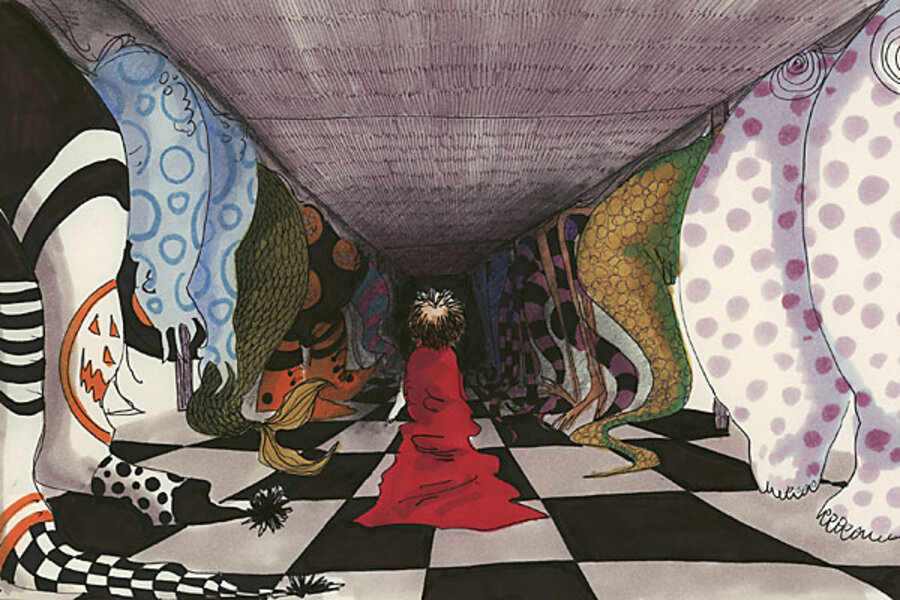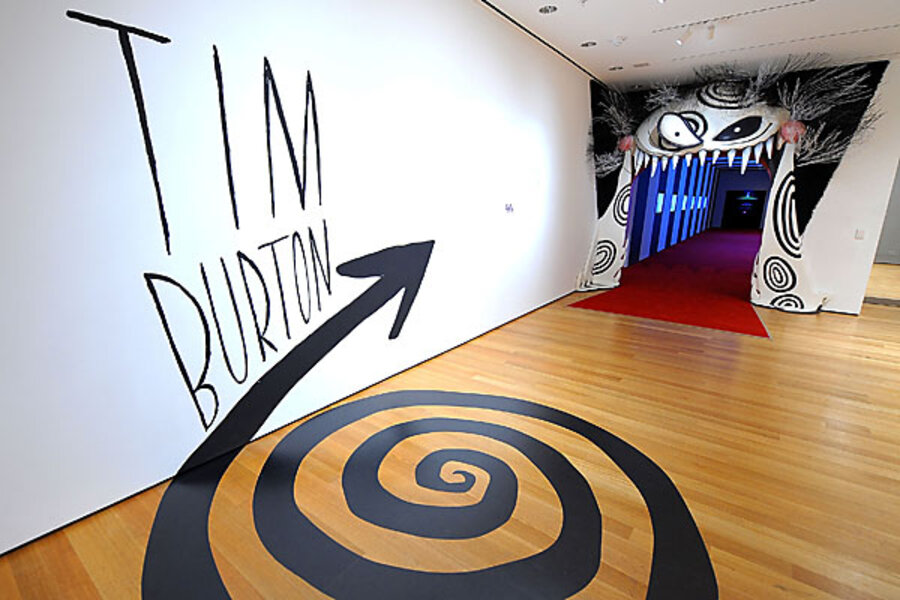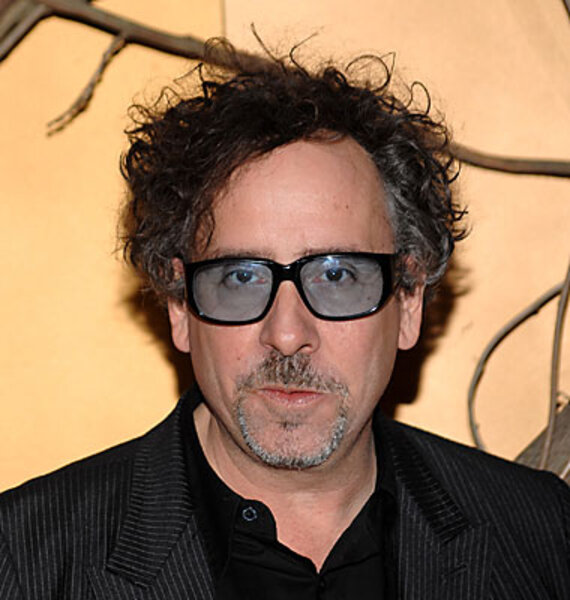Inside the mind of Tim Burton
Loading...
| New York
If a visit inside the mind of an enigmatic director were written as a screenplay, it might begin like this:
INTERIOR: MUSEUM OF MODERN ART, NEW YORK CITY – DAY
The VIEWER sees a spiral painted on the floor outside an art gallery, a symbol of unbalanced vertigo. She walks on a red-carpet “tongue” through a portal shaped like a toothy monster’s head. Six video monitors line a black-and-white striped corridor showing the misadventures of a hapless antisuperhero named Stainboy. LAUGHTER from other MUSEUM-GOERS. The viewer is plunged into a spooky room lit by black light, where an iridescent carousel revolves above a many-tentacled, phosphorescent sea creature.
ART CRITIC
“Welcome to the weird, wacky, wonderful world of Tim Burton’s imagination!”
Until April 26, 2010, the Museum of Modern Art hosts “Tim Burton,” an exhibition of 500 drawings, cartoons, paintings, sketches, photographs, and moving-image works by the director of hit films like “Beetlejuice,” “Edward Scissorhands,” and “Batman.” The display of original work is accompanied by screenings of his 14 feature films and 200 objects like props, “sculps,” and costumes fabricated for the films. Museum director Glenn Lowry terms it “the largest, most comprehensive monographic show to date devoted to a single filmmaker.” Mr. Lowry praises Burton for allowing curators access to his personal archive, which seems to include every doodle he ever scribbled from childhood ’til now.
“It’s rare an artist lets you inside their mind,” Lowry adds, providing “a glimpse of how they think and feel,” as well as “the issues that shape their work.” He saluted the director, saying, “Tim, you explore deep and dark fears we all share but in a way that brings out the humor and humanity in all of us.”
Many themes and motifs in the work stem from a painful childhood. Burton, born in Burbank, Calif., in 1958, felt alienated from his suburban environment, which he’s described as colorless and conformist. Estranged from his parents, the future goth-inspired director enjoyed playing in a local cemetery (no surprise there). A classic geek, he cloistered himself in his room, drawing fantastic creatures, seeking release and relief in his imagination. What he terms “the lurid beauty” of monster movies like “Godzilla” and horror films like “Nosferatu” attracted him. He identified with their misfit, misunderstood characters.
Burton spent two years at art school and four miserable years as an apprentice animator at Walt Disney Studios, where he unlearned more than learned the craft. Assigned to draw endearing foxes for the 1981 animated feature “The Fox and the Hound,” Burton’s beasts were the antithesis of cute. His foxes looked rabid or were smashed like roadkill – The Magic Kingdom as The Macabre Kingdom.
The exhibition makes clear how Burton’s early experiences shaped – and still inform – his art and filmmaking. The show is divided into three sections: Surviving Burbank (juvenilia like school papers, drawings, and lists of favorite movies), Beautifying Burbank (cartoons he drew as an art student and animator), and Beyond Burbank (concept drawings and sketches of characters in his films).
Common threads emerge in both drawings and films: monstrous but childlike creatures that elicit sympathy through their vulnerability, inventive costume, and set designs bursting with panache, and a distinctive mix of horror and humor.
“He’s a humorous artist,” says assistant curator of film Ron Magliozzi, who organized the show. “And ultimately I think he’s an optimistic artist. Look at how he survived when he was faced with any distressing situation. He didn’t respond by shutting down. He responded by producing more and more work – drawings and cartoons. Creative activity seems to be his response to stress.”
Burton’s woebegone heroes, too, seek consolation in creativity. The archetypal outsider Edward Scissorhands, a sweetly pathetic boy with blades for fingers who literally cannot touch another person, finds solace in sculpting topiary shrubs. Johnny Depp, who brought the character to life in the 1990 film, has said it was Burton’s initial sketches of the sad character, which “haunted” and “traumatized” him, that helped him internalize the outcast’s essence.
What makes the bizarre characters in Burton’s films appealing is his sympathy for them. “They come from a personal space,” says curatorial assistant Jenny He. “He makes emotional, subjective films, and even though the material may be dark and slightly macabre, it’s kind of innocuous and funny, so you’re not offended.”
The cartoons Burton produced during the 1980s bristle with adolescent humor. In one titled “Mental Floss,” an impossibly elongated figure holds a string in his bony fingers, using it to ream his brain through both ears. In “Curtis is giving his eyes a rest,” a man’s eyeballs dangle out on wires, with one reposing on a lounge chair, the other relaxing on a beach towel. The puns and verbal and visual humor are a hoot.
Burton’s gaudy style, which Mr. Magliozzi calls pop surrealism, is akin to Salvador Dalí in an antic mood. Pop media is clearly an influence: from the acid-tinged whimsy of Edward Gorey and jittery lines of cartoonist Gahan Wilson to the offbeat wit of Maurice Sendak and Charles Addams. Burton’s German Expressionist sensibility is indebted to early films like Fritz Lang’s “Metropolis” (adapted in the menacing set of “Batman”).
The show is so packed with eye candy, it’s like a circus and costume party
mashed into one eye-popping spectacle. And the inhabitants of Burtonia? Oyster Boy whose head is shaped like a clamshell, Charred Girl (a carbonized sculpture, wiry as a Giacometti sculpture), and a pink tree dripping with sea horses. It’s like a Curiosity Cabinet of Dr. Caligari.
A character in Burton’s “Charlie and the Chocolate Factory” proclaims, “Candy doesn’t have to have a point. That’s why it’s candy.” But this exhibition, despite the ample fun quotient, does have a point. It shows the vast range of Burton’s creative output,
on paper and onscreen, and his consistent concerns in whichever media.
Burton’s depressed superhero Stainboy (the hero of six animated shorts) faces adult disapproval but perseveres in his do-good missions. Yet he only succeeds in leaving a stain wherever he goes. In the fantasies he creates, Burton – although hardly a real caped crusader – empathizes with such underdogs and freaks. His uncompromising films leave not a stain but an indelible mark on our culture.
His high school English teacher was prescient in a summation of the teenage Burton’s essay “Humor in America.” He wrote: “Good job; some good original material well arranged.”







